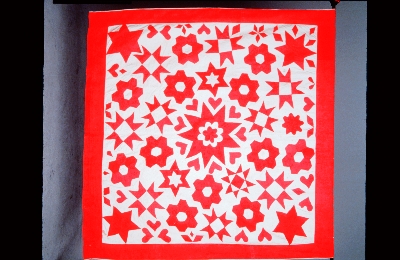Quilt No.756PHM - Powerhouse Museum

1960 x 1950mm
The quilt was a gift of the Royal Australian Historical Society in 1983. No earlier provenance information available. The quilt is used for research and exhibition purposes only.
"Although the identity of the maker of the quilt is unknown, we can presume much about her (or him) from the choice of materials and the design. Because of the apparent reuse of the kind of damask fabrics used to make table cloths and napkins for the patches and the border, we can presume the maker was concerned to practice economy. From the clarity and exhuberance of the design, we can also reconstruct a maker who had an excellent design sense. Because the bold combination of red and white was particularly popular in Ireland in the 1800s, we may even suppose that the maker was Irish." [PHM]
Related Quilts:
2360 x 2310mm
1790 x 1160mm
2290 x 1950mm
1474 x 1093mm






